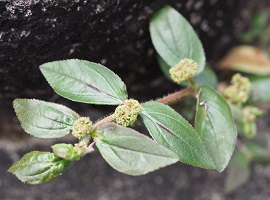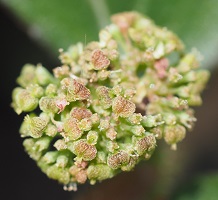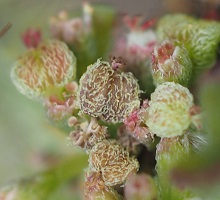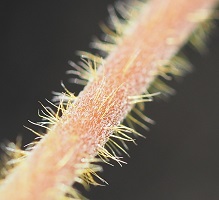| Home | Nature Weekly Index |
6 August 2017 | Asthma Weed | Parietaria Judaica | Euphorbia hirta |
Asthma Weed, guessing from its name, has something to do with asthma which is a common long-term disease affecting the airways of the lungs. Since the term is a common English name, it is not used exclusively for one plant. At least 2 plants are commonly referred to by this name --- one being known to cause asthma while the other is used to treat asthma.
The asthma-causing plant is Parietaria Judaica (Family: Urticaceae), also known as Pellitory. Its pollen is said to be the main causative agent. It is a plant of European origin but is found in Australia and is considered a noxious weed there. It is not available in Singapore at this time. A wild herb here that closely resembled this plant in term of overall appearance is Pouzolzia zeylanica (Graceful Pouzolzsbush) from the same family.
The asthma-relieving plant is Euphorbia hirta (Family: Euphorbiaceae), also known as Hairy Spurge. It is a very common weedy herb here.




Depending on the locations, the name Asthma Weed can mean different things and can be relatively dangerous if the wrong one was used in the concoction of the traditional medication, assuming that the right concoction really work in the first place. Interestingly, two animal studies [1, 2] from Malaysia published in 2013 appeared to showed different conclusions on the toxic effect of Euphorbia hirta on the kidney and liver tissues. One reported no abnormality while the other one indicated tissue injuries in theses organs.
To determined how well both plants were being studied, I did a search for publications separately using their botanical names as the key words in PubMed website and limit the search to the title of publications. The yield was 78 and 76 publications respectively for Euphorbia hirta and Parietaria Judaica. To put the numbers in perspective, a very common medicinal herb Andrographis paniculata yielded 316 publications, 4 times that of the 2 plants while a less common herb such as Pouzolzia zeylanica yielded only 4 publications. Though the amount of publications does not necessary correlate to the medicinal properties or importance of a plant, it does highlight the interest that researchers had on a plant.
References:
[1] Yuet Ping K, Darah I, Chen Y, Sreeramanan S, Sasidharan S. Acute and subchronic toxicity study of Euphorbia hirta L. methanol extract in rats. Biomed Res Int. 2013;2013:182064. | Read article |
[2] Wong JY, Chen YS, Chakravarthi S, Judson JP, L SR, Er HM. The effects of Euphorbia hirta on the ultrastructure of the murine liver, kidney and aorta. Exp Ther Med 2013 Nov;6(5):1247-1250. | Read article |